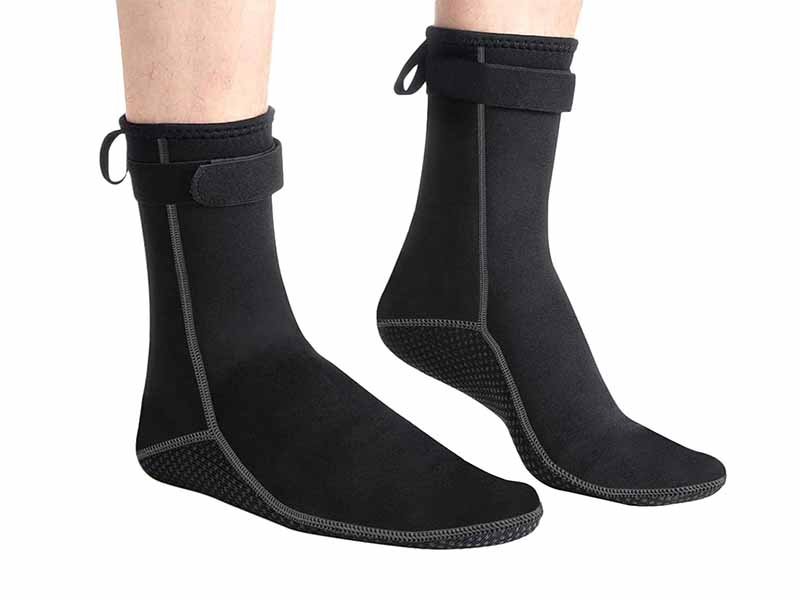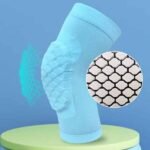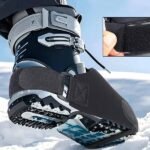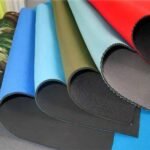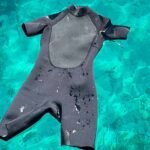If you’ve ever walked into winter ocean water, stepped onto icy rocks during a shore dive, or launched your paddleboard on a frosty morning, you know exactly how unforgiving cold water can be. Unlike cold air, which your body can somewhat tolerate, water pulls heat away from your skin up to 25 times faster. That means even a few minutes of exposure can numb your feet, reduce your balance, and cut a great session short. That’s where neoprene boots come in—and among the many thickness options available, 5mm neoprene boots are widely considered the “true winter standard.”
5mm neoprene boots provide reliable warmth in cold-water temperatures ranging from 7–14°C (45–57°F), depending on construction, seam sealing, and fit. They offer excellent insulation for winter surfing, cold-weather paddle sports, shallow diving, and kayaking. With proper design—such as glued-and-blind-stitched seams, thermal lining, and anti-flush ankle seals—5mm boots deliver strong cold-resistance without sacrificing too much flexibility.
But here’s the part many buyers underestimate: not all 5mm boots provide the same warmth. Two boots that claim “5mm thickness” can differ dramatically in insulation because warmth is not determined by thickness alone. Neoprene density, the lamination method, seam construction, sole design, lining technology, and even how well the boot fits your ankle all shape the real-world temperature performance.
Take the example of a European surf brand that tested three 5mm boot samples from different factories. Even though all were labeled “5mm,” testers consistently rated one pair as 30% warmer because the neoprene was higher density and the seams were sealed with liquid tape. Another pair felt cold because water seeped in through loose ankle cuffs. The difference wasn’t thickness—it was engineering.
Let’s break down everything buyers, outdoor enthusiasts, and OEM/ODM brands need to know about how warm 5mm neoprene boots really are—using science, real-world testing, and practical insight.
What Does “5 mm Neoprene” Mean in Boot Construction?

5mm neoprene refers to the thickness of the neoprene foam layer used in the boot’s key thermal zones, not the total material thickness. True 5mm boots use full 5mm panels in the toe, arch, and upper foot areas. Lining materials add additional thickness, making the total material closer to 5.5–6 mm. Construction techniques, foam density, and lamination all affect real insulation performance.
When customers or product buyers look at a neoprene boot labeled “5mm,” it seems straightforward—but the industry standard is more complex. Neoprene boots consist of multiple layers: the neoprene foam core plus interior and exterior linings. The “5mm” designation refers specifically to the foam core thickness. After lamination, the finished panel may measure closer to 5.5–6.0 mm.
1. The Real Composition of a 5mm Boot Panel
A typical 5mm boot panel includes:
- 5.0 mm neoprene foam core
- 0.5 mm outer nylon or abrasion-resistant jersey
- 0.4–0.7 mm internal lining (nylon, fleece, or titanium-reflective material)
So the actual finished thickness may total:
| Layer | Approx. Thickness |
|---|---|
| Neoprene Foam Core | 5.0 mm |
| Outer Lining | 0.3–0.5 mm |
| Inner Lining | 0.4–0.7 mm |
| Total | 5.7–6.2 mm |
This matters because buyers often compare 4mm vs 5mm vs 7mm boots purely based on labels, but the finished thickness can vary significantly.
2. Thickness Varies by Boot Zone
Most manufacturers do not use uniform thickness across the entire boot. Instead, they optimize by location:
| Boot Zone | Typical Thickness | Reason |
|---|---|---|
| Toe Box | Full 5mm | Maximum warmth |
| Upper Foot | 5mm | Cold-exposed area |
| Ankle Panel | 4–5mm | Mobility during flex |
| Heel | 4–5mm | Heel comfort + warmth |
| Sole | 6–8 mm (rubber) | Protection + ground insulation |
This is why your big toe often feels the warmest—because brands prioritize that area with uncompromised neoprene thickness.
3. Measurement Standards Differ by Factory
Premium neoprene factories measure foam thickness after lamination, ensuring customers get consistent insulation. Lower-cost producers may measure neoprene before lamination, leading to real thicknesses 0.3–0.8 mm thinner in practice.
This is especially important for private label buyers seeking consistent sizing and warmth across production batches.
4. Neoprene Type Affects Warmth Even at the Same Thickness
Two 5mm foams may have entirely different cell structures:
- Limestone neoprene: dense, warm, long-lasting
- N-type neoprene: high elasticity, premium
- SBR neoprene: inexpensive, compresses easily, loses warmth faster
Higher-density neoprene traps more air, reduces compression in water, and keeps feet warmer.
In short, “5 mm neoprene” is a specification—but real warmth depends on the entire construction system, not just that measurement.
How Warm Are 5 mm Neoprene Boots in Real Conditions?

5mm neoprene boots are designed for cold-water temperatures between 7–14°C (45–57°F). They offer significantly more insulation than 3mm or 4mm boots and are ideal for winter surfing, cold-weather paddle sports, shallow diving, and kayaking. Proper seam sealing, thermal linings, ankle-fit engineering, and minimal water flushing determine how warm they perform in real use.
Understanding real warmth performance involves combining lab data, athlete feedback, and environmental conditions. Water temperature affects the boot directly, while air temperature influences how quickly heat is lost when the foot is above water.
1. Temperature Suitability Chart
Below is a realistic temperature suitability range for 5mm boots:
| Water Temperature | Comfortable? | Notes |
|---|---|---|
| 16–20°C (61–68°F) | Too warm | 3mm is better |
| 12–15°C (53–59°F) | Ideal | Most winter sports |
| 9–11°C (48–51°F) | Good | With proper lining + sealing |
| 7–8°C (44–46°F) | Borderline | Brief use OK, but 6–7mm recommended for long sessions |
| Below 7°C (44°F) | Not ideal | Switch to 7mm |
This is why 5mm boots are the default for winter surfing in Europe, Northern US, Japan, and Korea.
2. Activity Level Changes the Perception of Warmth
Movement keeps your blood flowing. Stillness causes rapid cooling.
| Activity | Perceived Warmth |
|---|---|
| Surfing | Warmest – constant foot movement |
| SUP | Moderate – intermittent splashing |
| Kayaking | Colder – feet remain still |
| Shallow Diving | Varies – compression reduces insulation |
Diving in 5mm boots may feel significantly colder than surfing in the same boots because pressure compresses neoprene at depth.
3. Session Duration Alters Performance
A boot may feel warm for 30 minutes but cold after two hours.
Higher-end boots use thermal brushed linings or titanium insulation layers to extend warmth during long sessions.
4. Fit and Water Flushing Are Critical
Even the warmest boot can feel freezing if water circulates inside.
This is why ankle cuffs, internal gussets, and heel locking systems matter.
A snug fit traps warm water inside—like a wetsuit.
5. Wind Chill Makes a Difference
Even if water is mild, cold wind can chill the boot surface.
This is relevant for:
- SUP racing
- Beach walking during winter surf sessions
- Kayaking in windy lakes
- Fishing in winter
Some premium 5mm boots use wind-resistant outer fabrics to counter this.
In summary: 5mm is the sweet spot for real winter conditions—but only when paired with proper design and usage.
Which Design Features Maximize Warmth in 5 mm Neoprene Boots?
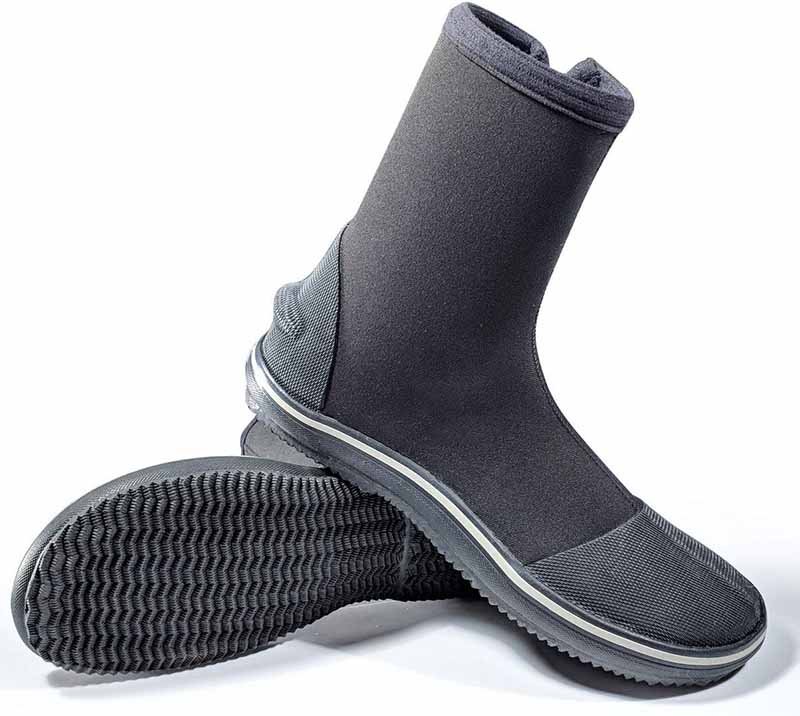
Warmth in 5mm neoprene boots depends heavily on seam sealing, lining material, sole insulation, and ankle-fit design. Glued-and-blind-stitched seams, liquid rubber sealing, thermal or titanium linings, and anti-flushing ankle systems significantly boost warmth. Proper construction can make a 5mm boot warmer than a poorly designed 7mm boot.
Every element of a neoprene boot plays a role in warmth retention. Even premium 5mm neoprene cannot perform well if the boot leaks water or compresses excessively.
1. Seams Are the Weakest Point—or the Strongest
Flatlock seams
- Breathable
- Allow water in
- Not suitable for 5mm cold-water boots
GBS (Glued & Blind Stitched)
- Most common in 4mm and 5mm boots
- Threads don’t fully penetrate neoprene
- Great balance between flexibility and warmth
Liquid Sealed Seams
- Best for maximum insulation
- Zero water penetration
- Very durable
- Premium option for winter divers and surfers
Poor seam sealing can reduce warmth by up to 40%.
2. Lining Materials Make a Huge Difference
| Lining Type | Warmth Level | Benefits |
|---|---|---|
| Nylon Jersey | ★★☆☆☆ | Quick-dry, budget |
| Fleece Lining | ★★★★☆ | Soft, higher insulation |
| Titanium/Metallic Lining | ★★★★★ | Reflects body heat |
| Poly-Thermal Brushed Lining | ★★★★☆ | Retains heat + dries faster |
Titanium linings are especially effective for cold-water users who want maximum warmth without extra bulk.
3. Sole Engineering Influences Heat Loss
The foot loses heat downward quickly, especially when standing on:
- Cold surfboards
- Ice-cold rocks
- Paddleboard decks
- Dive fin pockets
High-quality boots include:
- Multi-layer rubber soles
- EVA thermal insulation layers
- Reinforced arch panels
- Anti-slip tread design
This is why many surfers prefer thicker, molded soles despite the slight weight increase.
4. Ankle Seal and Anti-Flushing Systems
Cold water flushing is the #1 cause of heat loss in winter boots.
Winter-ready boots use:
- Glideskin seals
- Tapered ankle cuffs
- Velcro or elastic straps
- Internal gussets
Some premium models have a double-cuff system.
5. Toe and Heel Reinforcement
These high-impact areas benefit from:
- Bumper rubber
- Textured rubber wrapping
- Abrasion-resistant toe caps
Better reinforcement reduces compression and adds warmth.
In short:
A well-designed 5mm boot with premium materials can outperform a cheaply made 7mm boot.
Do 5 mm Neoprene Boots Lose Warmth at Depth or in Harsh Conditions?
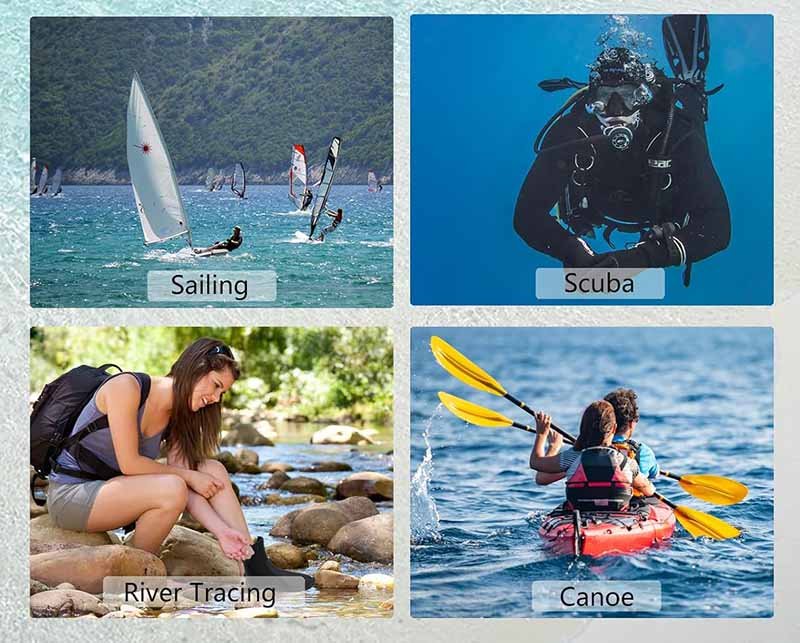
Yes. Neoprene compresses under water pressure, reducing its thickness and insulation. A 5mm boot may compress to 3–4 mm at moderate dive depths, lowering warmth. Wind chill, surface exposure, flushing, and extended cold-water sessions also reduce warmth. Proper fit, lining technology, and seam sealing help mitigate these effects.
Even the best neoprene boots cannot defy physics. Understanding how 5mm boots behave under different environmental stresses is essential for choosing the right gear.
1. Neoprene Compression Reduces Warmth During Dives
At 10–20 meters depth:
- 5mm neoprene may compress to 3–4 mm
- Air bubbles inside neoprene collapse
- Insulation drops by up to 25–45%
This is why divers in cold waters often choose 6.5mm or 7mm boots.
2. Wind Chill Makes Boots Feel Thinner
Cold wind accelerates heat loss when:
- Walking on the beach
- Standing on rocks
- Paddle boarding in winter
- Kayaking in windy lakes
A 5mm boot with fleece lining may feel like a 4mm boot in heavy wind.
3. Water Flushing Is a Warmth Killer
Even premium neoprene cannot retain heat if cold water circulates inside.
Common causes:
- Loose ankle collar
- Oversized boot
- Poor gusset design
- Worn-out seams
This is why pro surfers always choose snug-fitting boots.
4. Long Durations Reduce Perceived Warmth
The longer your session:
- The more heat is eventually lost
- Even warm boots feel colder after 2–3 hours
- Fingers and toes lose circulation faster
Titanium linings help extend warmth retention.
5. Exposure Surfaces Affect Warmth
Standing on:
- Sand
- Wet rock
- Aluminum kayak floors
- SUP deck pads
- Cold concrete
… all accelerate heat loss through the sole.
This is why sole thickness and insulation matter as much as neoprene thickness.
In summary:
5mm boots stay warm in most cold-water conditions, but physics still applies—compression, flushing, and wind chill all affect real performance.
When Should You Choose 5 mm Boots Instead of 3 mm, 4 mm, or 7 mm?

Choose 5mm neoprene boots for cold-water conditions between 7–14°C (45–57°F). They offer stronger insulation than 3mm or 4mm boots and are ideal for winter surfing, cold SUP, fishing, kayaking, and shallow diving. For freezing water or deep dives, 6.5mm–7mm boots are recommended.
Choosing boot thickness depends on environmental conditions, activity type, sensitivity to cold, and mobility preferences.
1. Thickness Comparison Chart
| Thickness | Warmth | Flexibility | Best Use |
|---|---|---|---|
| 3mm | ★★☆☆☆ | ★★★★★ | Warm water, high mobility |
| 4mm | ★★★☆☆ | ★★★★☆ | Cool water, fall/spring surf |
| 5mm | ★★★★☆ | ★★★☆☆ | Winter surf, cold SUP/kayak |
| 7mm | ★★★★★ | ★★☆☆☆ | Freezing water & diving |
5mm is often considered the “winter all-rounder.”
2. When 3mm Boots Are Too Thin
Avoid 3mm when:
- Water is below 15°C
- Your feet get cold easily
- You surf in windy conditions
- You participate in stationary activities (kayak, fishing)
3mm boots lose heat too quickly in cold-water scenarios.
3. When 4mm Boots Are Not Enough
4mm works well for mild winter, but:
- In northern climates, 4mm is often too thin
- Cold air + cold wind reduce warmth
- Long sessions cause warmth drop-off
This is where 5mm truly shines.
4. When 7mm Boots Are Necessary
Choose 6.5–7mm when:
- Water is below 7°C
- You dive deeper than 10–15m
- You paddle in icy lakes
- You fish in winter for long periods
But 7mm boots have downsides:
- Less flexibility
- Heavier
- Harder to dry
- Reduced board feel (surfers dislike this)
5. Why 5mm Boots Are the Best “Universal” Cold-Water Option
5mm strikes a balance between:
- Strong insulation
- Manageable weight
- Decent flexibility
- Good durability
- Reasonable drying time
This is why the majority of winter surfers worldwide prefer 5mm.
What Should Buyers Check When Choosing or Customizing 5 mm Boots?
To select or customize 5mm neoprene boots, evaluate neoprene type, foam density, seam sealing (GBS or liquid tape), inner lining materials, outsole construction, and ankle-fit design. Brands should request production samples, verify true thickness, check sizing consistency, and ensure anti-flushing features. Partnering with a reliable OEM factory helps maintain quality and customization flexibility.
For OEM/ODM buyers—surf brands, outdoor brands, retailers—choosing a manufacturer for 5mm neoprene boots is a significant decision. Quality variations directly impact customer satisfaction, return rates, and brand reputation.
1. Check Neoprene Type
| Type | Benefit | When to Use |
|---|---|---|
| Limestone Neoprene | Warmest + eco-friendlier | Premium surf brands |
| N-type neoprene | High elasticity + warmth | Mid–high level boots |
| SBR neoprene | Budget-friendly | Entry-level boots |
High-density neoprene stays warmer longer.
2. Inspect Seam Construction
A proper winter boot must use:
- GBS seams minimum
- Liquid taped seams for premium models
- Reinforced heel stitching
Loose or uneven seams cause cold spots.
3. Evaluate Lining Technology
High-quality linings:
- Dry faster
- Retain warmth
- Improve comfort
- Reduce odors
For cold water:
titanium-coating + thermal fleece is ideal.
4. Focus on Outsole Engineering
The outsole is critically important.
A good sole must:
- Insulate
- Protect
- Grip
- Flex
Look for:
- Multi-layer rubber design
- EVA thermal midlayer
- Anti-slip texture
- Molded toe guards
5. Check Fit and Anti-Flushing Design
Fit issues account for most returns.
When sampling:
- Check ankle collar tightness
- Test heel slip
- Confirm toe-box volume
- Evaluate strap tension
Brands serving cold-water markets should always add glideskin cuffs.
6. Request Size-Consistency Control
Quality factories maintain:
- U.S. / EU size grading systems
- Consistent last molds
- Tight tolerance manufacturing
This ensures fewer returns.
7. Customization Options for Brands
Factories like neoprene-bag can customize:
- Toe type (round or split-toe)
- Lining material
- Logo method (rubber patch, silk print, heat transfer)
- Color accents
- Sole design
- Packaging
Are There Myths About the Warmth of 5 mm Neoprene Boots?
Thickness isn’t the only factor determining warmth. Neoprene density, seam construction, lining technology, outsole insulation, and boot fit influence performance more than thickness alone. A high-quality 5mm boot can outperform a poorly constructed 6–7mm boot.
There are several misconceptions about neoprene boot warmth that mislead buyers and customers.
Myth 1: “Thicker Boots Are Always Warmer”
Not true.
A poorly made 7mm boot with flatlock seams may feel colder than a premium 5mm boot with:
- High-density neoprene
- Liquid-sealed seams
- Thermal lining
Myth 2: “All 5mm Neoprene Performs the Same”
Foam density, cell size, and lamination determine warmth.
Cheap 5mm neoprene compresses faster → less insulation.
Premium neoprene keeps its thickness even under pressure.
Myth 3: “Fit Doesn’t Matter as Long as It’s 5mm”
Even perfect neoprene can’t retain heat if water flushes in.
Myth 4: “Lining Is Just Decoration”
Lining is an insulation layer.
Titanium-coated lining reflects heat back toward the skin.
Myth 5: “Sole Thickness Doesn’t Affect Warmth”
Cold transfers fastest through surfaces.
A thick, insulated sole matters more than people think.
In practice:
Warmth = neoprene + lining + seams + fit + activity + environment.
Thickness alone tells only part of the story.
How Can Brands Customize Their 5 mm Neoprene Boots for Different Markets?
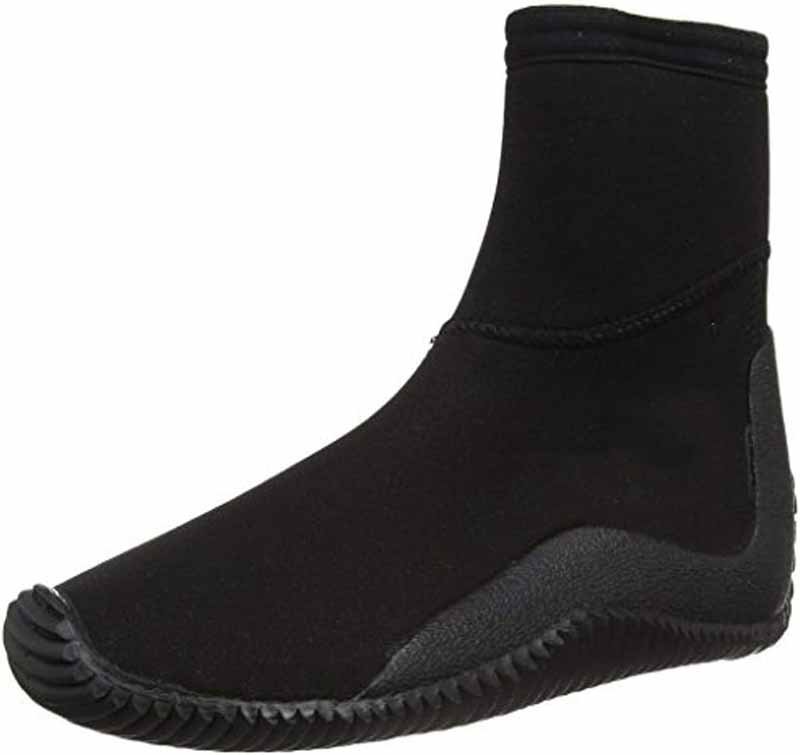
Brands can customize 5mm neoprene boots by choosing toe style, lining type, outsole structure, seam sealing method, color accents, logo application, and packaging. Market-specific factors—such as climate, water temperature, athlete preferences, and price targets—should guide thickness, materials, and construction choices. Reliable OEM factories offer low MOQs and fast sampling.
Different markets require different boot specifications. A one-size-fits-all approach leads to poor performance and customer dissatisfaction.
1. Climate-Based Customization
Europe (UK, France, Ireland, Norway)
- Cold water
- Strong winds
- Prefer titanium lining + liquid seams
USA (California, Oregon, East Coast)
- Winter surf markets prefer high ankle seals
- Split-toe models are common
Japan & Korea
- High attention to comfort and finish
- Multi-panel construction popular
Australia & New Zealand
- Range from warm to cold
- Brands often offer 3mm + 5mm models
2. Toe Style Options
- Round Toe (warmest)
- Split Toe (best board feel)
- Hidden Split Toe (balance between the two)
3. Lining Options
- Basic nylon (budget)
- Thermal fleece (comfort)
- Titanium lining (premium warmth)
- Quick-dry brushed lining (hybrid markets)
4. Sole Options
- Molded rubber
- EVA mid-layer insulated
- Anti-slip textured
- Flexible thin soles (for surf)
- Reinforced soles (for rocky coasts)
5. Logo Applications
- Rubber label patch
- Silk screen
- Heat transfer
- Embossed rubber molds
6. MOQ & Production Planning
Factories like neoprene-bag typically provide:
- Low MOQ 100–300 pairs
- Sampling in 3–5 days
- Bulk production 15–25 days
This flexibility supports new brands, seasonal launches, and small-batch premium lines.
Conclusion — Ready to Customize Your 5mm Neoprene Boots?
5mm neoprene boots are the perfect balance of winter warmth, flexibility, and performance. They deliver reliable insulation for cold-water surfing, SUP, kayaking, fishing, and shallow diving. But as this guide explains, the real warmth of a 5mm boot depends not just on thickness—but on neoprene density, seam construction, lining technology, sole engineering, ankle sealing, and fit.
For brands, retailers, and outdoor companies, choosing the right manufacturer is essential. A professional neoprene partner ensures product consistency, customized design, and stable quality.
neoprene-bag.com is a specialized neoprene R&D and manufacturing factory with:
- 18+ years manufacturing neoprene boots, wetsuits, gloves, bags, covers
- 100% quality inspection
- Free design support
- Low MOQs
- Fast sampling (3–5 days)
- Private label & OEM/ODM for global brands
If you’re ready to develop your own 5mm neoprene boots—or any neoprene product—just tell me your specifications. I can help prepare your product sheet and sampling request for the factory.

